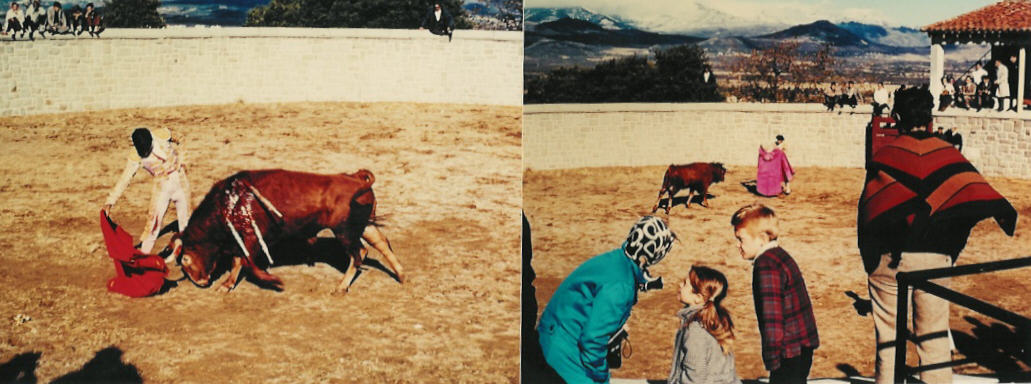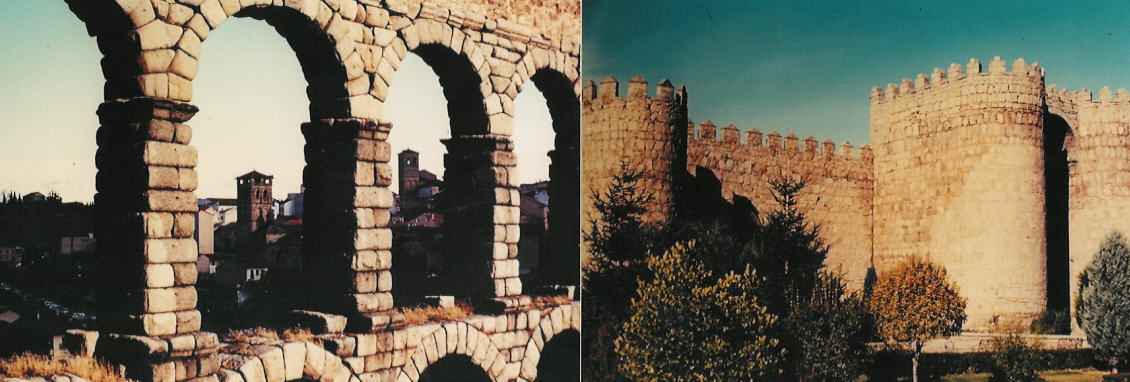
Spain, Morocco (1968)
Bull Fights and Snake Charmers In late October of 1968, Val, Jill, Rob and I took the night ferry from Genoa to Barcelona as the start of a ten day drive through Spain capped by a day trip to Morocco. Marnie stayed behind with Tom and Sue Lowenberg and their four boys.Once again we found the Italian ferry lines a nice way to travel . . . clean and new (built this year), stable (nobody got seasick) and reasonably fast (maybe two to four hours longer than making the trip by car). There was an very nice cafeteria on board and the big feature, at least for the kids, was the evening movie in the ship’s lounge.
Arriving in Barcelona in the morning, we hit the road immediately for Madrid over a barren expanse of desert and rock formations not unlike our Southwest. We got within fifty miles of Madrid and stayed overnight in a roadside inn. Since in Spain you eat even later than in Italy . . . earliest is 8:30 p.m. . . . we stopped at about 7 p.m. stretched our legs or rested, then went down for dinner. This was the pattern we followed for most of the trip.
Madrid We arrived in Madrid by nine the next morning and headed straight for the Prado . . . the Spanish national art museum . . . which the Spaniards think surpasses s the Louvre in Paris. It contains an overwhelming collection with most of our Italian artists well represented . . . Raffaello for example . . . but the greatest concentration naturally is with the Spanish artists . . . Velasquez, Goya and El Greco. Jill and Rob picked up a little of our enthusiasm and seemed even to enjoy the morning there.
We left at noon for Segovia through the rocky fields where the fighting bulls are bred and raised. At one spot, I left the main road to take a few pictures of the bulls and we happened upon a private bullfight in progress. Apparently a bull breeder was putting on a demonstration for buyers or friends. We didn’t ask too many questions but just walked into the stands where waiters in white jackets were passing drinks around to the guests. So the kids saw their first bull dispatched and I got a lot of great slides.
 |
Segovia. Segovia, our overnight stop, is famous for two things . . . a Roman aqueduct, ninety feet high which runs through the main part of town and sill functions as it did two thousand years ago and a perfectly preserved Alcazar (fortified castle) which, in fact, was used for filming the external scenes in the movie Camelot . . . more like a Walt Disney creation that the piece of history that it really is. We had a guided tour . . . and Rob liked the armor, cross-bows, maces, etc which are collected there. Jill was impressed when the guide told her she was standing in the room where Christopher Columbus first approached the Spanish Queen Isabella with the idea of financing his adventure. (She didn’t give him the money until their second meeting in Seville, however). We had some extra excitement in the hotel where we stayed with three simultaneous but separate wedding receptions going on that evening. Val even got asked to dance.
 |
Roman Aquaduct at Segovia Walled City of Avila
Toledo The next day we headed for Toledo by way of Avila, which is an charming, old city completely surrounded by a high wall built in and still intact from the 12th Century. We saw it first five years ago in the Frank Sinatra - Sophia Loren movie ‘The Pride and the Passion’. I can see why Hollywood makes a lot their movies in Spain. Their was excitement that night, too, in Toledo when the hotel we stayed in was being used to film a French movie. It was a low budget film and you’ll never see it in your local theater . . . but as you can imagine, the kids were very impressed by the actors, make-up applications, klieg lights, etc.
We liked Toledo which is famous for it’s silver work . . . but probably were most impressed with the tour of the Alcazar . . . which withstood a sixty day siege during the Spanish civil war before it fell. The story of the commander who told the opposing commander "Go ahead and shoot my son . . . the Alcazar will never be surrendered" left such an impression on Jill that when she was back in school and was asked to tell about her trip she recited the conversation between the two generals almost word for word from the transcription of their telephone call.
Seville It was a full day’s drive from Toledo to Seville. Did you know that the cigarette factory in Seville where Carmen worked really exists and is now turned into a college? The highlight of our overnight stay was our evening in a little club watching flamenco dancing. The show didn’t start until 10:30 p.m. but it was a once-in-a-lifetime opportunity for the kids so they came along, too. It was very entertaining in its pure and classic form. Jill especially loved it.
Before leaving Seville, we stopped at the West Indies Company museum . . . and old, vaulted library in which all the contracts, records, ship’s logs, etc from the days of the Spanish explorers are kept. We saw letters from Columbus (written in Spanish surprisingly), Magellan, Cortez and the rest of the names I remember from Mrs. Nelson’s seventh grade history class. We also stopped in a department store for souvenir shopping . . . which included a heavy, hand-woven wool bedspread which is now covering our bed. That night we made it down to Algeciras on the southern coast of Spain and stayed in a hotel on the beach overlooking the bay to Gibraltar. The next day we jumped continents.
Morocco. At the last minute we signed up for a guided tour of Tangier a one hour hydrofoil ride across the Mediterranean into Morocco. Upon arrival we arranged for a guided tour with an affable Moroccan named Mohammed, who hired a cab and took us for a ride into the country overlooking Tangier and to the point of land which marks the convergence of the Atlantic and the Mediterranean sea . . . the north-west tip of Africa. Along the road we passed a few camel drivers . . . who I’m quite sure spent ninety percent of their time putting tourists on and off camels for photo ops . . . and very little time, if any, driving the camels anywhere in particular. Of course, we had to have our pictures taken on camel-back, too. Jill and Rob were intrigued by the rather complicated process by which the camel gets to his feet and then back down again.
 |
Following our drive we returned to Tangier and wandered through the Casbah. It was just like a movie set with the beggars, the veiled women and the snake charmers crowding the narrow. In one little back street we encountered a snake charmer, who put a snake around Rob’s neck while his assistant played the drum. Jill chose not to participate. I think one of the snakes was a cobra . . . although I’m not sure because my eyes were closed most of the time.
We continued our walk to the Sultan’s palace with its many harem rooms and finally to a restaurant where the guide left us for dinner. Rob meandered over by the musicians, who were playing a strange combination of stringed instruments. One of the musicians gave Rob his lute and showed Rob how to strum it. Rob ended up strumming his way through the next number . . . . which had to be one of the strangest sights and sound combinations I’ve ever experienced . . my seven year old son strumming his way through the latest tune of the Arab hit parade accompanied by three strange, robed Moslems. We finished up the day by buying a hand-woven carpet, a camel-seat ottoman and a few other souvenirs before returning to the docks for the five o’clock hydrofoil.
Return Trip. The drive back up to Barcelona was more driving than stopping . . . first through the Sierra Nevada mountains . . . then to Valencia and up the coast. One all-too-short stopover was at the Alhambra . . . the one-time capital of the Moslem world when the Moors occupied Spain. It was the home of Sultan and his wives and was unbelievably elaborate and decorative.
We stayed at two great hotels on the way back . . . one in Malaga and one in Valencia . . . both government owned and operated. This chain of state hotels (called "paradors") is part of Franco’s plan to attract tourism. I don’t see how the private hotels can compete. The "paradors" are magnificent locations and beautifully decorated . . . often built out of an historic castle or building . . . and the room rates were only four dollars a night for the four of us.
We caught our ferry in Barcelona for the return crossing to Genoa. The return was as pleasant as the ride over with the advantage that we returned home early and rested after a relaxing cruise along the Mediterranean coast . . . instead of late and tired as we would have been had we driven back from Spain.